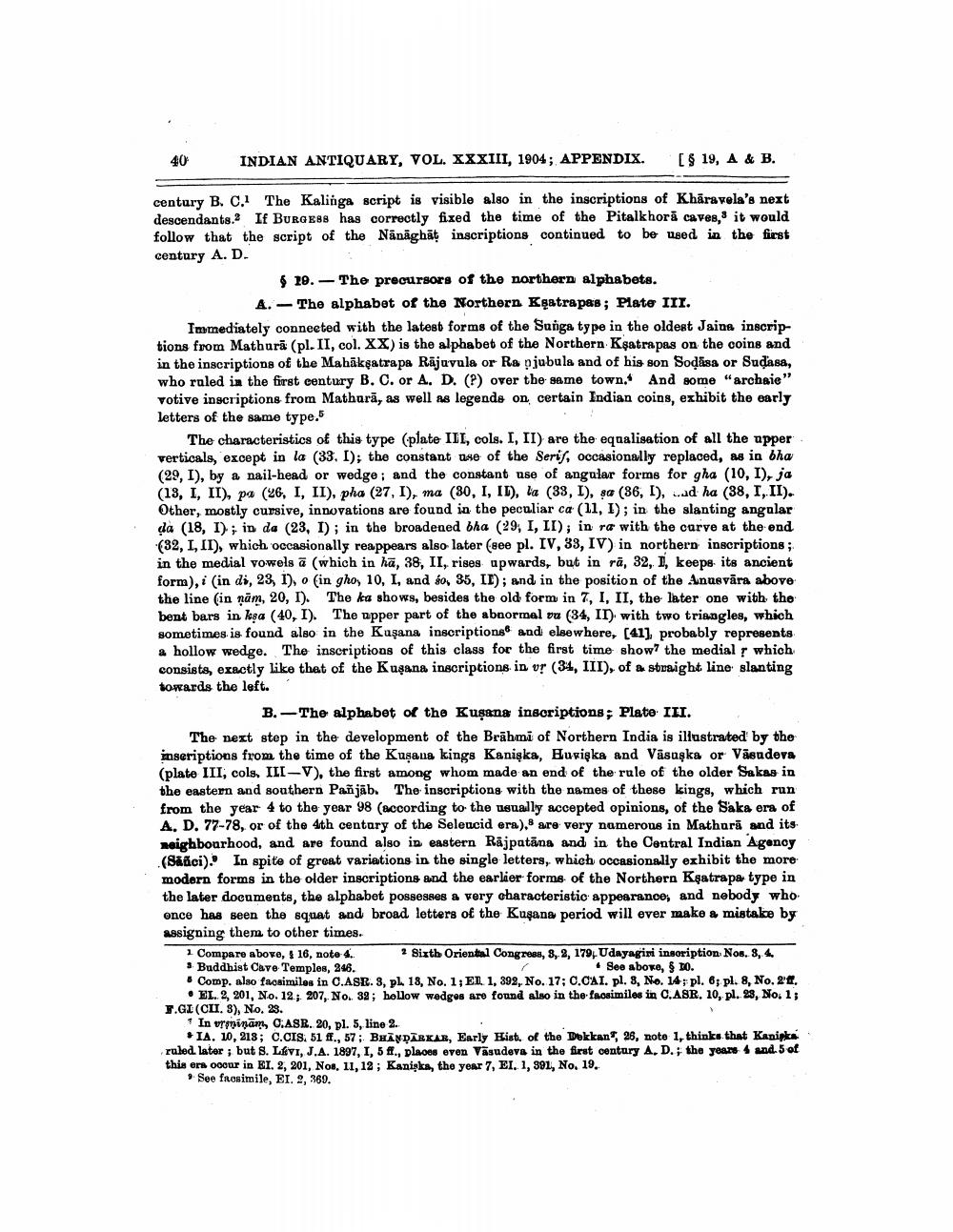________________
INDIAN ANTIQUARY, VOL. XXXIII, 1904; APPENDIX.
[$ 19, A & B.
century B. C. The Kalinga script is visible also in the inscriptions of Khāravela's next descendants 2 If BURGESS has correctly fixed the time of the Pitalkhoră caves, it would follow that the script of the Nänäghāt inscriptions continued to be used in the first century A. D.
29. - The precursors of the northern alphabets.
A. - The alphabet of the Northern Kgatrapas; Plate III. Immediately connected with the latest forms of the Sunga type in the oldest Jains inscriptions from Mathurā (pl. II, col. XX) is the alphabet of the Northern Ksatrapas on the coins and in the inscriptions of the Mahākşatrapa Rājuvula or Ra pjubula and of his son Sodisa or Sudasa, who ruled in the first century B.C. or A. D. (?) over the same town. And some "archaie" votive inscriptions from Mathurā, as well as legends on certain Indian coins, exhibit the early letters of the same type.
The characteristics of this type (plate III, cols. I, II) are the equalisation of all the upper verticals, except in la (33. I); the constant use of the Seris, occasionally replaced, as in bha (29,1), by a nail-head or wedge; and the constant use of angular forms for gha (10, I), ja (13, I, II), pa (26, I, II), pha (27, I), ma (30, I, ID), la (33, I), sa (86, I), ad ha (38, I,II). Other, mostly cursive, innovations are found in the peculiar ca (11, I); in the slanting angular da (18, I); in da (23, 1); in the broadened bha (29, I, II); in ra with the carve at the end (32, I, II), which occasionally reappears also later (eee pl. IV, 33, IV) in northern inscriptions ; in the medial vowels ā (which in hā, 38, II, rises upwards, but in rā, 32, 1, keeps its ancient form), i (in di, 23, 1), o (in gho, 10, I, and so, 35, ID); and in the position of the Angsvāra above the line (in nām, 20, 1). The ka shows, besides the old form in 7, I, II, the later one with the bent bars in kşa (40, I). The upper part of the abnormal oa (34, IT) with two triangles, which sometimes is found also in the Kuşana inscriptions and elsewhere, [41], probably represents a hollow wedge. The inscriptions of this class for the first time show the medial r which consists, exactly like that of the Kuşana inscriptions in vr (34, III, of a straight line slanting towards the left.
B.-The alphabet of the Kuşans inscriptions; Plate III. The next step in the development of the Brāhmi of Northern India is illustrated by the inseriptions from the time of the Kuşana kings Kanişka, Huviska and Väsuşka or Vasudeva (plate III, cols. ILI -V), the first among whom made an end of the rule of the older Sakas in the eastern and southern Pañjāb. The inscriptions with the names of these kings, which run from the year 4 to the year 98 (according to the usually accepted opinions, of the Saka era of A, D. 77-78, or of the 4th centary of the Seleucid era),8 are very numerous in Mathurā and its neighbourhood, and are found also in eastern Rajpatāna and in the Central Indian Agency (Säici). In spite of great variations in the single letters, which occasionally exhibit the more modern forms in the older inscriptions and the earlier forms of the Northern Kşatrapa type in the later documents, the alphabet possesses a very characteristic appearance, and nebody who once has seen the squat and broad letters of the Kuşana period will ever make a mistake by assigning them to other times.
1 Compare above, $ 16, note 4.. 2 Sixth Oriental Congress, 8, 2, 179, Udayagiri inscription Nos, 8, 4. Buddhist Cave Temples, 246.
See above, $ 20. • Comp. also facsimiles in C.ASR. 3, P18, No. 1; EL 1, 392, No. 17; C.CAI. pl. 8, No. 14; pl. 6; pl. 8, No. 2 ff.
• EL. 2, 201, No. 12; 207, No. 39; hollow wedges are found also in the facsimiles in C.ASR. 10, pl. 23, No. 13 F.GL (CII. S), No. 28.
In vrmiņām, C.ASR. 20, pl. 5, line 2.
IA. 10, 218; C.CIS. 51 ff., 57; BHĀNDĀRKAR, Early List of the Dokkan, 26, note 1, thinks that Kanipa ruled later ; but S. LEVI, J.A. 1897, 1, 5 ff., places even Vasudeva in the first century A. D.; the years 4 and 5 of this era occur in EI. 2, 201, Nos, 11, 12; Kaniska, the year 7, EI, 1, 391, No. 19.
See facsimile, EI. 2, 369.




